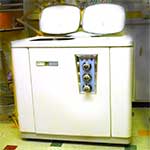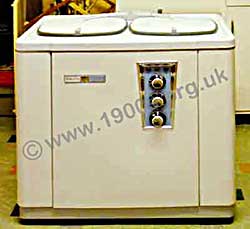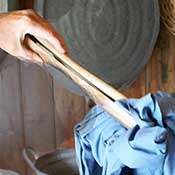Twin tub washing machines, mid-20th Century

Twin-tub washing machines were popular in Britain in the 1950s as the first type of washing machine that was accepted by the mass market. As the name implies, they had two separate tubs – one for washing and rinsing the laundry and the other for spinning and draining. This page explains their popularity at the time, describes their use and highlights their very distinct disadvantages.
____
By the webmaster based on personal domestic experience, discussions with others and additional research
Twin tub washing machines - a godsend but an expensive one
There can be little doubt that twin tub washing machines must have been a godsend to housewives in the 1950s who, until then, had to use the bagwash or laundrette for the household washing unless they were prepared for the drudgery of hand washing and mangling.
Prices, mid-20th Century
Twin tub washing machines were expensive in real terms. By no means all families could afford one.
The cost of a twin tub washing machine
contributed by Ruth Summersides, personal recollections
In 1962 I got a brand new twin tub washing machine. I saw it advertised in a magazine. It was pink and blue. I can't remember the name, but I remember the price was £39.95. We put down a deposit and paid monthly.
My mother never had one, and when my husband and I were first married in the early 1960s, we couldn't afford one either. Only after a few years, when we moved into our own house, did we decide to buy one, and that was when my experience with twin tub washing machines began. It was distinctly not good.

Twin tub washing machine, photographed in the Willis Museum, Basingstoke
Major disadvantages
Essentially the washing machine was far too labour-intensive and time-consuming in use. Yes, it was semi-automatic in that it did save the pummelling and squeezing of washing by hand, and we didn't have to go out to laundrette, but - and it was a big but ... Read on.
Our twin tub was not plumbed in. I suppose it could have been, but that was clearly not expected because the manufacturers supplied two hoses. One was for filling the wash tub and the other was for emptying the other tub. The one for filling had to be attached to the hot water tap in the sink and be hooked over the wash tub and the other had to be hooked over the sink for drainage. Neither the filling nor the emptying was automatic.
Someone had to stand over the wash tub while it filled, ready to turn off the tap when the tub was full. Then someone had to add the washing powder and set the washing going. The time that this lasted could be set. Then that someone had come back to use large wooden tongs to pull the washing out of the wash tub and put it into the other tub to drain or spin. It was steamy business, even standing back and using the tongs.

Once the washing had spun or drained, it had to be returned to the wash tub, which now had to be filled with new water for rinsing. This to-ing and fro-ing between the two tubs had to be repeated several times, depending on how many rinses were wanted.
As for the quality of the wash, that was another disadvantage. Our model washed by rotating the clothes in just one direction. Probably later models agitated; I don't know. The result was that the clothes wound together and had to be unwound to separate them and were probably not as clean as I would have liked.
Why we got rid of our twin tub washing machine
Automatic washing machines for the domestic market were coming in around this time, and although they were more expensive than twin tub machines, we felt we had little realistic alternative but to buy one. So the days of our twin tub were short-lived.
Some households, though, kept their twin tub machines for many years.
| sources | webmaster | contact |
Text and images are copyright
If you can add anything to this page or provide a photo, please contact me.



